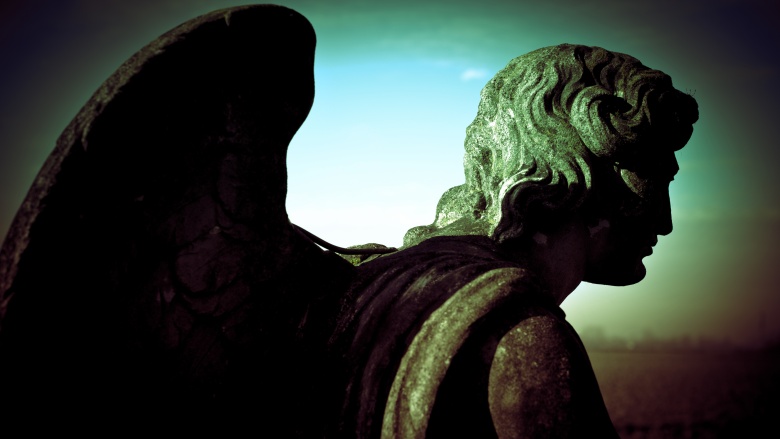The Real Stories Behind Bizarre Events In History
They say truth is stranger than fiction. Open a history book, and you'll see why. History is packed with incredibly odd moments, and it's sometimes difficult to learn the facts behind these strange stories. But if you wade through all the silliness, superstition, and speculation, you can discover the real stories behind history's bizarre events.
The Halley's Comet panic of 1910
Named after astronomer Edmond Halley, Halley's Comet only passes by Earth every 76 years or so. When it buzzed our planet in 1910, it sparked a lot of interest — according to Wired.com, telescope sales skyrocketed as the comet neared. Hotels even offered special deals, so people could gather on top of their roofs to watch the meteor pass.
Of course, not everyone was pleased with the comet's appearance, as many believed the shooting star would end civilization. This crazy idea came courtesy of Camille Flammarion, a French astronomer who believed the comet's 24-million-mile long tail contained a poisonous cyanogen gas that "would impregnate the atmosphere and possibly snuff out all life on the planet."
Unfortunately, The New York Times did a piece on Flammarion's apocalyptic theory that encouraged some less-trustworthy newspapers to run wild with the story. So in addition to telescopes, people started ransacking stores for gas masks. Con men made a killing by selling anti-comet pills, and some people worried the comet would "cause the Pacific to change basins with the Atlantic" and turn the world into "one heterogeneous mass of chaotic confusion." Worried parishioners flocked to their churches, and according to science writer Matt Simon, people actually sealed up their keyholes to keep poison out of their homes.
When the comet finally passed, however, the gas masks proved totally worthless, as there was no poison. Sure, a few people blamed the meteor for King Edward VII's death, but there's not a lot of science backing that claim. Interestingly, Mark Twain also passed away as the comet flew overhead. That's extra weird considering he was born as the comet last flew by, in 1835.
John Glenn's fireflies
John Glenn holds a special place in US history. He was part of the Mercury Seven (the first group of American astronauts), and he was the first American to orbit Earth. On February 20, 1962, he climbed aboard the Friendship Seven and blasted into the atmosphere. While monitoring the Mercury spacecraft, Glenn circled the planet three times in about five hours. But of course, he also spent some time watching the Sun rise and set, rise and set.
And then, the fireflies showed up. As Glenn was circling the Earth a second time, he looked outside Friendship Seven to see his spacecraft was surrounded by tiny glowing lights. Awestruck, Glenn told Mission Control that he was "in a big mass of thousands of very small particles that are brilliantly lit up like they're luminescent." He described them as yellowish-green and said each orb looked like "a firefly on a real dark night."
Neither Glenn nor NASA knew what was happening. While some might've suspected extraterrestrials, the astronaut believed it was a sort of miracle. However, these fireflies had a simple, more realistic explanation. The Mercury spacecraft was equipped with a vent that projected the astronaut's bodily fluids—think sweat and urine—into space. When the liquid was shot into the void, it froze instantly, and if the light hit it at just the right angle, those droplets would glow like a thousand little "celestial fireflies."
The death of Edgar Allan Poe
On September 27, 1849, Edgar Allan Poe was supposed to travel from Richmond, Virginia, to Philadelphia. He was going to help a fellow writer edit some poetry ... but Poe never made it to the City of Brotherly Love. Instead, he somehow wound up in Baltimore, Maryland. Nobody knows how he got there or what was doing there, but when he was discovered on October 3, the author was in serious trouble.
Poe was found lying in the street outside a saloon called Gunner's Hall, barely conscious and wearing somebody else's worn-out clothes. Tragically, the writer spent his last days either unconscious, or delirious. When he wasn't in a coma, he was thrashing around so badly that he had to be strapped down. And while he never could explain what had happened to him, he kept repeating the name, "Reynolds."
The writer eventually died on October 7 — since then, there have been all sorts of wild theories about the cause of his death, ranging from mercury poisoning to rabies. But while there's no shortage of speculation, there is one theory that seems more likely than the rest. Many historians think Poe was the victim of cooping. See, in the 19th century, voting was actually kind of dangerous. Crooks known as "coopers" would grab people off the streets, beat them up, and get them drunk or high on opium. The victims were then forced to vote at multiple polling places, but in order to disguise these drugged-up voters, the coopers would dress their victims in shabby disguises.
The cooping theory accounts for both Poe's change of clothes and his delirious state. Even more convincing, Poe was discovered on Election Day, in front of a saloon that doubled as a polling place.
What really happened to the "Mary Celeste"
There's nothing quite as creepy as a ghost ship, and perhaps the most famous of all is the Mary Celeste. Captained by Benjamin Briggs, the merchant ship left New York on November 1872. In addition to Briggs, the Mary Celeste carried his wife, his infant daughter, several sailors, and around 1,700 barrels of alcohol, all heading for Italy.
According to Briggs' diary, the trip was pleasant, but before they made it to Europe, something unusual happened. The Mary Celeste was discovered sailing along without a single person aboard. However, the lifeboat was gone, and there was a strong rope running from the ship into the sea. While the hatch doors had been removed, there weren't any other signs of distress. The Mary Celeste looked good as new. Tragically, no one ever found Captain Briggs or the crew. Some historians have blamed waterspouts for their disappearance, while others have considered pirates, giant waves, or mutinous sailors. But there's little evidence to support those theories.
However, 19th century investigators did find something strange. Of the 1,700-odd barrels on board, nine were empty. Not only that, but those nine barrels were made of red oak, while the others were made of white. So, what's the significance there? Well, as Brian Dunning of Skeptoid explains, white oak is watertight, whereas red oak is porous. It's likely that 300 gallons of alcohol seeped out of those red oak barrels and began evaporating in the ship's hold. Worried the alcohol might explode, the sailors tried venting the room by removing the hatch doors, but to no avail.
Desperate, everyone gathered in the lifeboat, but not before tying the raft to the Mary Celeste. That way, they could trail along from a distance, and not worry about the larger vessel sailing away. Unfortunately, before they could make a plan to deal with the alcohol, it seems the rope was accidentally sliced in two. The Mary Celeste quickly floated off, leaving ten terrified humans lost in the Atlantic Ocean.
The angels of Mons
In August 1914, World War I was just getting started. The Germans were preparing to invade France, but they first had to get through the British Expeditionary Force (BEF). While vastly outnumbered, the Brits had more experience, and they met the Germans at Mons, Belgium. The BEF managed to stall the Germans for a bit, but unfortunately, they were forced to retreat.
Well, that's one story, anyway. According to some people, Mons was actually a British victory. When the going got tough, a band of angels descended from the heavens and decimated the Germans. This Old Testament tale spread across England, courtesy of books, newspapers, and churches. Many of the English faithful sincerely believed otherworldly beings had shown up at Mons with flaming swords, so how did this celestial story get started?
BS journalism, that's how. Weeks after the battle, a fiction writer named Arthur Machen penned a short story called "The Bowmen." In this alt-history tale, ghostly medieval archers appear at Mons to help fight the Germans. The story was published in The Evening News and, while it was clearly made-up, "The Bowmen" sowed the seeds for what happened next. In April 1915, a story called "A Troop of Angels" was published in numerous newspapers and magazines. In the article, two unnamed soldiers reported seeing angels on the battlefield. Things were further confused when The Occult Review published a false story asserting every soldier at Mons had seen divine beings. Then in 1931, Brigadier-General John Charteris published letters he'd written during the war — one mentioned the angels, but historians believe that letter was forged after the battle, for propaganda purposes.
It really seems like "The Bowmen" stirred up a few overactive imaginations, and while the story grew more elaborate over the years, it all got started with a silly short story.
The Mad Gasser of Mattoon
In autumn of 1944, the town of Mattoon, Illinois, went into full-fledged panic mode. On September 1, a woman and her three-year-old daughter took ill after smelling a sweet odor in their home. The mother became paralyzed but, while she soon regained her mobility, her husband later spotted a mysterious prowler outside the house. Their story appeared in The Daily Journal-Gazette, a local newspaper which implied more "attacks" could follow. Sure enough, shortly after the report, three people came forward with similar accounts. According to one couple, they'd woken up on August 31 after detecting a sickly smell. The husband started throwing up, while the wife couldn't move her legs. A few hours later in a separate house, a mother couldn't help her sick child because she literally couldn't get out of bed.
The newspapers declared these "attacks" were the work of a "Mad Gasser," and for the next two weeks, multiple people claimed they were victims of the "Phantom Anesthetist." On September 5, a woman found a wet cloth outside her home. When she picked it up, she passed out. The next day, eight different people said their homes had been gassed. Things got so crazy, the FBI began investigating. But on September 13, over 20 victims later, the attacks just ... stopped.
The police never captured the Gasser, but that's probably because he didn't exist. Doctors never found anything wrong with the victims, police never found traces of chemicals, and the Phantom didn't leave footprints. So what sparked the panic? While some blame emissions from nearby industrial plants, the Mad Gasser was probably the result of mass hysteria, whipped up by irresponsible reporting from the local paper.
The most mysterious disease in the world
The world has seen its fair share of awful epidemics, but no modern-day disease has been quite so mysterious as Encephalitis lethargica. The sickness first appeared in 1916, but it really started spreading during the '20s. The disease caused all sorts of symptoms like tremors, psychosis, and drowsiness, and it was incredibly lethal, killing around a million people. Those who survived were often locked inside their own bodies. A staggering 20% of victims were invalids for the rest of their lives, and only 14% ever fully recovered. Making things worse, doctors had no clue what was happening. They knew the disease attacked the brain (E. lethargica means "inflammation of the brain that makes you tired"), but that was about it. They didn't know where it came from, or how to stop it.
Then, in the late '20s the disease simply vanished, leaving a staggering number of comatose patients in its wake. For decades, it seemed like the sickness was gone for good, until it reared its ugly head in 1993, infecting approximately 20 people. This time around, however, a trio of doctors—John Oxford, Andrew Church, and Russell Dale—cracked the E. lethargica code. These medical professionals discovered that most modern-day victims had started off with sore throats, caused by a rare form of streptococcus. This bizarre bacterium would then mutate and cause the immune system to attack the brain. With that in mind, the researchers looked back at old cases and discovered that, in the 1920s, many patients suffered from sore throats caused by — you guessed it — a kind of streptococcus.
Unfortunately, while scientists now have a good idea of what causes this "sleepy sickness," there's still no cure.
The New England vampire panic
In 1882, in Exeter, Rhode Island, Mary Eliza Brown died of tuberculosis. Known at the time as "consumption," the disease literally "consumed" people, causing the body to rapidly deteriorate, along with intense fevers and nasty coughs. But Mary Eliza wasn't the only victim in the Brown family. Her daughter Mary Olive passed away in 1883, and about a decade later, 19-year-old Mary Lena Brown also died of consumption.
Mary Lena's brother, Edwin, was incredibly ill as well. Hoping a better climate would improve his condition, the young man went west. Unfortunately, when he returned, he was only getting worse. And that's when his neighbors developed a truly bizarre idea. What if one of the Brown women was crawling out of her grave at night and feasting on Edwin's blood? Wouldn't that explain his sickly condition?
Determined to get to the bottom of things, a group of men exhumed all three women. Mary Eliza and Mary Olive were basically just bones, but when they brought out Mary Lena, her body was still fresh. After the vampire hunters cut open her heart, they found chunks of coagulated blood. Certain she was an undead monster, they burned Mary's heart and liver ... and fed the ashes to Edwin.
Obviously, Mary Brown wasn't a vampire. So why was her corpse in such good shape? Well, for one thing, she'd only been dead for a few months. Plus, Mary died in January, when it was freezing outside. Since it was winter and too cold to dig, her body had been stored in a stone vault, which acted as a refrigerator, thus preserving her corpse. Also, since she wasn't a vampire, the macabre cure didn't work on Edwin, and he died a few months later.
The woman who gave birth to rabbits
In September 1726, an Englishwoman named Mary Toft gave birth to something that looked like cat intestines. And when local obstetrician John Howard arrived at her home, he helped Toft deliver several cat legs and nine dead baby rabbits. Baffled, Howard wrote to medical experts in London. Soon, word of the miraculous births made their way to King George I himself. Curious, the king sent Nathaniel St. Andrew, his personal surgeon-anatomist, to investigate. And on the day he showed up, Mary Toft gave birth to Rabbit #15.
Shockingly, both St. Andre and John Howard really thought Toft was delivering rabbits. They believed she'd been startled by a rabbit while pregnant, and that's why she was giving birth to baby bunnies. This insane theory was called "maternal impression," (or, as we call it today, "wrong"), but not everyone bought into it. It was determined the rabbits' lungs couldn't have developed inside Toft's womb. Plus, one physician found droppings inside a dead bunny that contained hay and straw. Crazier still, after Toft delivered half a rabbit, someone noticed the animal had been cut in two with a knife.
Still, St. Andre was convinced Toft was a baby-bunny-mama, and he brought her to London for closer examination. Upon her arrival, Toft became the talk of the town. People flocked to see the legendary mother, and her story was covered in major newspapers. But once she was in London, Toft ... stopped giving birth. As if that weren't suspicious enough, a servant was caught sneaking a rabbit into her room. After one doctor threatened to perform surgery on her, Toft confessed it was all a hoax. Hoping to earn money in freak shows (and scam a few prominent doctors on the side), Toft had been shoving the rabbits inside her vagina and then pushing them out. Please do not even think of trying this at home.
The battle of Los Angeles
In the months after Pearl Harbor, America was on edge, especially in California. On February 23, 1942, a Japanese submarine had fired on an oilfield near Santa Barbara — the next day, Naval intelligence indicated an enemy attack was imminent. So the next day, when radar detected an unidentified aircraft heading toward Los Angeles, the city turned into a battlefield.
After the object appeared onscreen, officials ordered a city-wide blackout. As there was no Moon that night, Los Angeles was plunged into darkness. The city's anti-aircraft batteries were readied for action, and then someone sighted a balloon carrying a red flare. Suddenly, the night sky turned into a terrifying light show. The military fired over 1,400 rounds into the air, and soldiers spotted all kinds of planes traveling at varying speeds and at wildly different altitudes.
But when the smoke cleared, there were no signs of an invasion, and the Navy quickly claimed the incident was due to jitters. The Army wasn't so sure, mentioning the possibility of enemy aircraft. But where had they come from, and where did they go? The Army didn't know. These conflicting reports prompted criticism from the government and major newspapers. Things were especially bad since all that anti-aircraft shrapnel had caused property damage, and a few citizens had died due to heart attacks and traffic accidents.
So what really happened that night? Well, we can probably blame it all on a weather balloon. When one drifted over L.A., the soldiers freaked out. Making things worse, the sky was dark and full of smoke, so shell bursts were probably mistaken for Japanese planes. While some conspiracy theorists think aliens were involved, we can probably point the finger at meteorologists.









